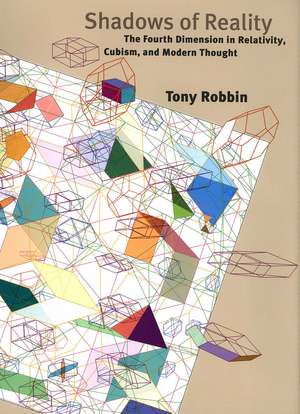Shadows of Reality: The Fourth Dimension in Relativity, Cubism, and Modern Thought
Autor Tony Robbinen Limba Engleză Hardback – 31 mar 2006
A pioneering artist continues his visionary inquiry into hyperspace
In this insightful book, which is a revisionist math history as well as a revisionist art history, Tony Robbin, well known for his innovative computer visualizations of hyperspace, investigates different models of the fourth dimension and how these are applied in art and physics. Robbin explores the distinction between the slicing, or Flatland, model and the projection, or shadow, model. He compares the history of these two models and their uses and misuses in popular discussions. Robbin breaks new ground with his original argument that Picasso used the projection model to invent cubism, and that Minkowski had four-dimensional projective geometry in mind when he structured special relativity. The discussion is brought to the present with an exposition of the projection model in the most creative ideas about space in contemporary mathematics such as twisters, quasicrystals, and quantum topology. Robbin clarifies these esoteric concepts with understandable drawings and diagrams.
Robbin proposes that the powerful role of projective geometry in the development of current mathematical ideas has been long overlooked and that our attachment to the slicing model is essentially a conceptual block that hinders progress in understanding contemporary models of spacetime. He offers a fascinating review of how projective ideas are the source of some of today’s most exciting developments in art, math, physics, and computer visualization.
In this insightful book, which is a revisionist math history as well as a revisionist art history, Tony Robbin, well known for his innovative computer visualizations of hyperspace, investigates different models of the fourth dimension and how these are applied in art and physics. Robbin explores the distinction between the slicing, or Flatland, model and the projection, or shadow, model. He compares the history of these two models and their uses and misuses in popular discussions. Robbin breaks new ground with his original argument that Picasso used the projection model to invent cubism, and that Minkowski had four-dimensional projective geometry in mind when he structured special relativity. The discussion is brought to the present with an exposition of the projection model in the most creative ideas about space in contemporary mathematics such as twisters, quasicrystals, and quantum topology. Robbin clarifies these esoteric concepts with understandable drawings and diagrams.
Robbin proposes that the powerful role of projective geometry in the development of current mathematical ideas has been long overlooked and that our attachment to the slicing model is essentially a conceptual block that hinders progress in understanding contemporary models of spacetime. He offers a fascinating review of how projective ideas are the source of some of today’s most exciting developments in art, math, physics, and computer visualization.
Preț: 434.11 lei
Preț vechi: 563.79 lei
-23% Nou
Puncte Express: 651
Preț estimativ în valută:
83.14€ • 85.66$ • 69.65£
83.14€ • 85.66$ • 69.65£
Carte tipărită la comandă
Livrare economică 22 februarie-08 martie
Preluare comenzi: 021 569.72.76
Specificații
ISBN-13: 9780300110395
ISBN-10: 0300110391
Pagini: 160
Ilustrații: 90 b-w + 8 color illus.
Dimensiuni: 191 x 267 x 14 mm
Greutate: 0.57 kg
Editura: Yale University Press
Colecția Yale University Press
ISBN-10: 0300110391
Pagini: 160
Ilustrații: 90 b-w + 8 color illus.
Dimensiuni: 191 x 267 x 14 mm
Greutate: 0.57 kg
Editura: Yale University Press
Colecția Yale University Press
Notă biografică
Tony Robbin has had more than twenty-five solo exhibitions of his paintings and sculpture since his debut at the Whitney Museum of American Art in 1974. He is a pioneer in the computer visualization of four-dimensional geometry and the author of Engineering a New Architecture, published by Yale University Press.
Recenzii
"Robbin’s insights may well be among those that lead our scientific, artistic, and general society to new understandings of our world."—Charles H. Scheim, Hartwick College
"Robbin’s discussion of Picasso’s summer 1910 painting, Seated Woman with a Book, is exciting and brand new."—Jan Schall, The Nelson-Atkins Museum of Art
"Shadows of Reality is a high-energy ride through hyperspace. Robbin exercises his preference in favor of understanding higher dimensional spaces via projection and projective geometry. His tour starts at the beginning of the twentieth century with special relativity and ideas of four-space and moves on to the advent of cubism, the emergence of quantum theory, quasi-crystals, the spin network and twistor theories of Roger Penrose, modern views of quantum non-locality, and the geometry and topology of higher category theory."—Louis H. Kauffman, author of Knots and Physics
"So what is this book? It is a combination of art, history of art, science and mathematics and their respective histories; it is philosophy and it is enlightening."—Scott Carter, University of South Alabama
"A fascinating flythrough of … intellectually rigorous climes . . . . The panorama he sketches in Shadows of Reality is rich and fascinating."—Science
“Robbin’s book is a provocative, illuminating adventure … offering novel insights into both math and art history.”—Ivars Peterson, Science News
